Top 10 national parks to visit this summer and the weather you can expect
The national parks offer a diversity of natural beauty, wonders and weather, as showcased in this list of our 10 favorite national parks.
Celebrating our National Parks: Wild, wonderful Yellowstone
Rick Hoeninghausen, Director of Marketing and Sales at Yellowstone Park Lodges, joined FOX Weather to talk all things Yellowstone.
Nothing says summer quite like a visit to one of the country’s more than 400 national parks scattered across the nation.
According to the National Park Service, more than 318 million people around the world visit the park system every year.
The national parks offer a diversity of natural beauty, wonders and weather, as showcased in this list of our 10 favorite national parks.
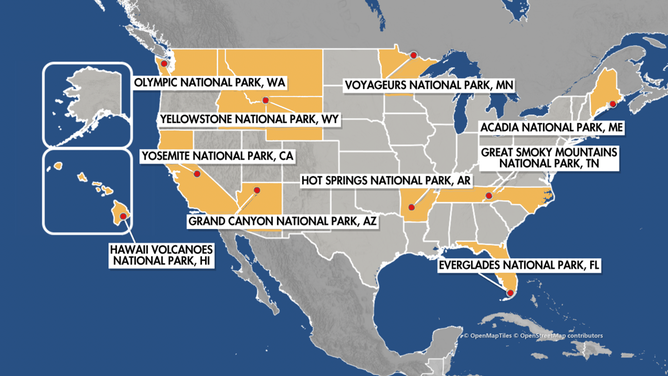
Top 10 National Parks to visit this summer.
(FOX Weather / FOX Weather)
Hawaii Volcanoes National Park
Hawaii Volcanoes National Park is where visitors can see two of the world’s most active volcanoes, Kilauea and Mauna Loa.
Despite the tropical location of Hawaii, the weather at the park is frequently chilly, rainy and foggy, according to the NPS. This is due to the park’s high elevation, rising up to about 4,000 feet on Kilauea and nearly 14,000 feet on Mauna Loa.
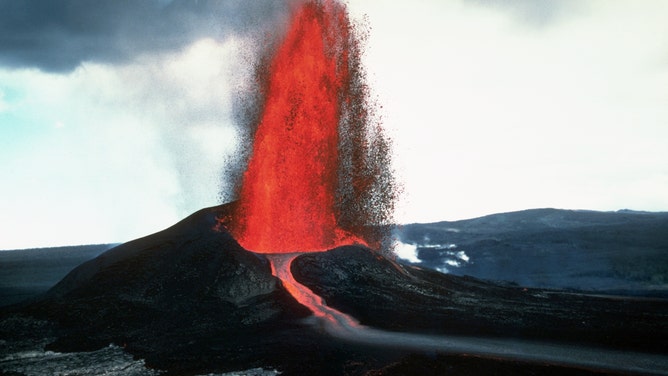
The Kilauea Volcano erupts with great force, shooting a lava fountain high into the air.
(CORBIS / Getty Images)
This range in elevation makes it so that weather can vary greatly at the park. In fact, while winter temperatures and snow are possible during any season at Mauna Loa’s summit, the park’s coastal plain at sea level usually experiences weather that is hot, dry and windy.
VOLCANO CAM: WATCH MESMERIZING VIEWS OF MAUNA LOA’S LAVA FOUNTAIN ERUPTING
Olympic National Park
In northwestern Washington, Olympic National Park offers visitors lush, green, temperate rainforests.
Its rich landscapes are largely due to the 12 feet of rain parts of Olympic National Park receive every year, making it the rainiest park in the country.

View of Sol Duc Falls on the Olympic Peninsula in the Olympic National Park in Washington State.
(Wolfgang Kaehler / LightRocket / Getty Images)
According to the NPS, the weather in Olympic is variable and unpredictable. The temperatures may vary 10-20 degrees, particularly at higher elevations and along the coast, and different weather conditions may exist within the park at the same time.
HERE ARE THE BEST NATIONAL PARKS TO SPOT BALD EAGLES
Yosemite National Park
Yosemite National Park in central California covers about 1,200 square miles in the Sierra Nevada mountain range, according to the NPS. It offers breathtaking views of the Yosemite Valley and waterfalls that pour down cliffsides.
During the summer, average high temperatures in the park can climb into the high 80s in July and August but then dip down into the upper 20s in December and January.
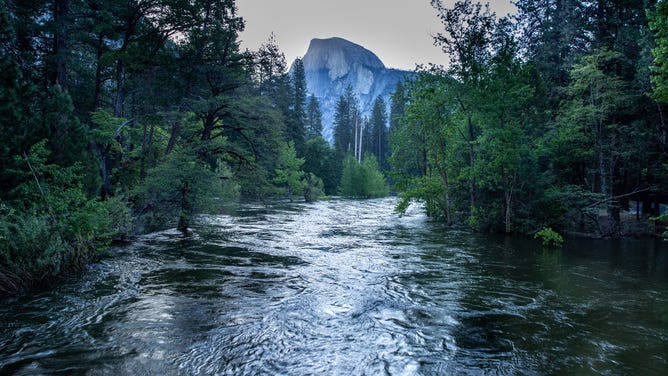
A flooding Merced River and Half Dome are viewed on May 25, 2023, in Yosemite National Park, California.
(George Rose / Getty Images)
The weather at Yosemite can be rainy from October through May, when it receives 95% of its annual precipitation. Over the winter, much of that precipitation falls as snow, which melts and flows into the park’s waterways during the spring and summer.
FLOODS THREATEN YOSEMITE NATIONAL PARK OVER FOURTH OF JULY WEEKEND
Grand Canyon National Park
In northern Arizona lies one of the Seven Natural Wonders of the World, Grand Canyon National Park. According to the NPS, the snaking canyon measures up to 6,000 feet deep and up to 18 miles wide.
Because of its sheer size, the Grand Canyon is capable of influencing the weather. The NPS said many different microclimates are found throughout the canyon, as its depths and rough terrain strongly influence solar heating and air circulation.
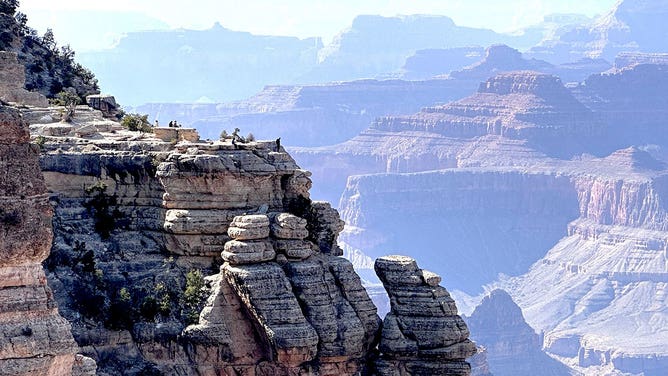
Tourists stand on an outcropping at Grand Canyon National Park in Arizona during the spring of 2023.
(Robert Ray / FOX Weather)
For example, the wettest location in the canyon is the North Rim, with an average of 25.8 inches of moisture a year, while the driest location is the Lees Ferry, where only 6.1 inches of precipitation fall each year on average.
GRAND CANYON NATIONAL PARK OFFERS 277 MILES OF BREATHTAKING VIEWS AND ADRENALINE-PUMPING HIKES
Yellowstone National Park
Yellowstone National Park is the oldest national park in the U.S. Stretching across Idaho, Montana and Wyoming, the park is 2.2 million acres large and features incredible sights from bison, wolves and other wildlife to about half of the world’s active geysers, such as Old Faithful.
Much like some of the other parks on this list, Yellowstone has unpredictable weather due to its elevation. The NPS said visitors can expect big temperature swings, rain or snow during every month of the year.
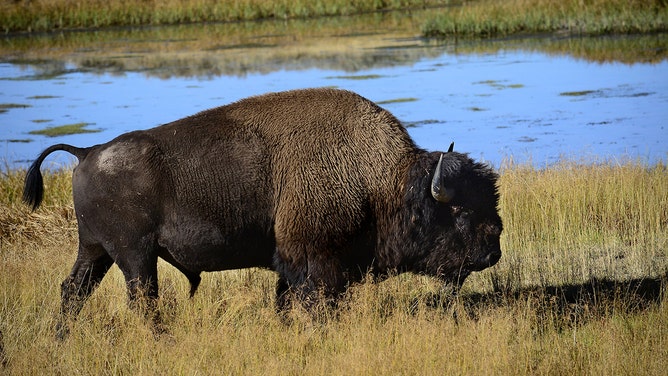
A bison grazes on grasses in the Hayden Valley section of Yellowstone National Park in Wyoming.
(Robert Alexander / Getty Images)
During the summer, average high temperatures are usually about 70 degrees and can rise up to 80 degrees at lower elevations but can drop below freezing at night at higher elevations.
Voyageurs National Park
Up north in Minnesota lies Voyageurs National Park. According to the NPS, Voyageurs is an adventure wonderland featuring both land and aquatic ecosystems for visitors to explore and enjoy.
The weather in Voyageurs includes four distinct seasons, with the summer months of June, July and August seeing periods of mild weather. Summer temperatures are usually in the mid- to upper 70s on average but can rise up to 90 degrees.
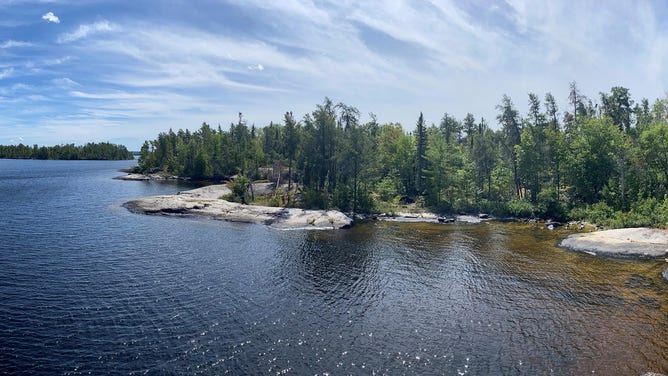
Voyageurs National Park in Minnesota.
(NPS / FOX Weather)
Precipitation during the summer usually averages between 3 and 4 inches.
MINNESOTA’S VOYAGEURS NATIONAL PARK OFFERS BEAUTIFUL LANDSCAPES TO EXPLORE
Hot Springs National Park
Hot Springs National Park offers both natural beauty and rich local history. From historic bathhouses to the geothermal features that fuel them – and the park – the Arkansas park has much to offer visitors.
Summer at Hot Springs National Park can be particularly warm, with daytime temperatures usually in the 80s and 90. In July and August, the temperature can rise into the triple digits with a humidity of 70-90%.
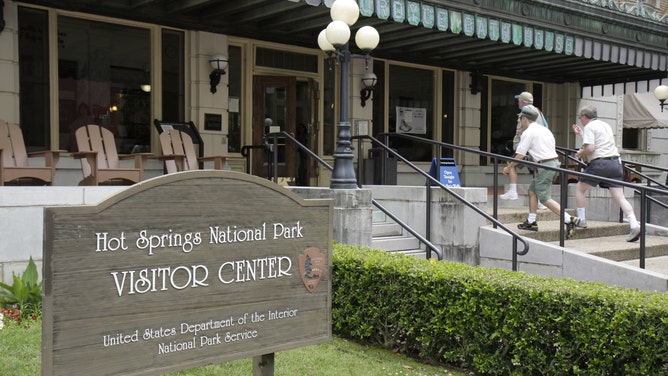
In 1832, President Andrew Jackson signed legislation to protect the area that would later become Hot Springs National Park in Arkansas.
(Jeffrey Greenberg / Universal Images Group / Getty Images)
Be it in the summer or any other time of year, visitors should note that the park can experience severe weather. Thunderstorms are common during the summer and spring, with spring having the highest potential for tornadoes, according to the NPS.
AMERICA’S JACUZZIS: HOW HOT MAGMA GAVE US HOT SPRINGS
Great Smoky Mountains National Park
Along the border of Tennessee and North Carolina rests Great Smoky Mountains National Park. The park is home to a variety of plant and animal life of the ancient Appalachian Mountains and is home to Southern Appalachian mountain culture, according to the NPS.
Summer in the park can be warm, hazy and humid, with showers and thunderstorms often popping up in the afternoon. Temperatures can rise to the 90s in the lower elevations, while the higher elevations usually experience more pleasant temperatures.
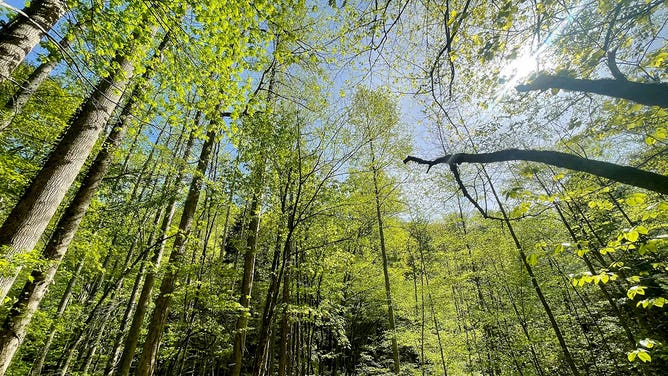
The sun shines through a canopy of trees at Great Smoky Mountains National Park in Tennessee during the spring of 2023.
(Nicole Valdes / FOX Weather)
Precipitation in the summer usually falls about 5.5 inches per month on average.
Everglades National Park
On the southern tip of Florida is the largest subtropical wilderness in the country, Everglades National Park. The NPS said the park is home to a number of rare and endangered species, such as the manatee, American crocodile and Florida panther.
Unlike some of the other parks on this list, Everglades National Park only has two seasons, wet and dry. The wet season includes warm, humid and rainy summers, while the dry season includes mild, dry winters with periodic blasts of cool air.
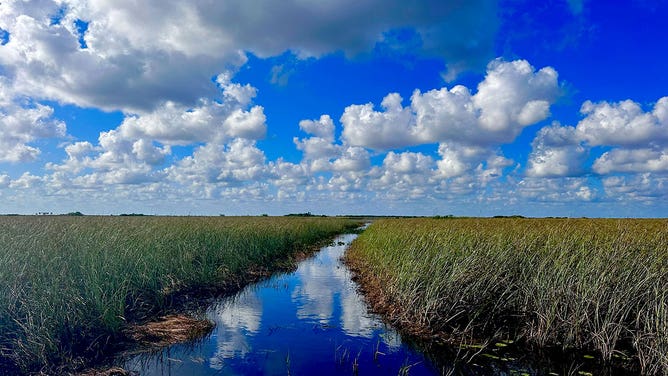
Clouds move across a blue sky above Everglades National Park in Florida during the spring of 2023.
(Robert Ray / FOX Weather)
Summertime visitors to the park can expect to feel temperatures that climb into the low 90s, along with some rain. As its name implies, the wet summer season is when the park sees most of its annual rainfall.
HERE ARE THE MOST POPULAR NATIONAL PARKS FOR BIRDWATCHING
Acadia National Park
Acadia National Park is located in the northeastern corner of the country in Maine. Known as the "Crown Jewel of the Atlantic Coast," Acadia National Park offers visitors an abundance of habitats to explore, and a rich cultural heritage nestled in the highest rocky headlands along the Atlantic coastline, according to the NPS.
THESE NATIONAL PARKS OFFER STARGAZING EVENTS
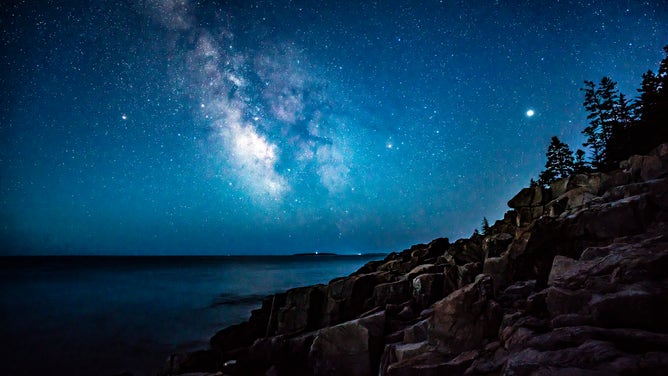
The Milky Way shines above the ocean off the coast of Acadia National Park in the early morning hours of Monday, April 23, 2018. Night skies in northern Maine consistently place first in a rating of darkness, meaning there is less light pollution and allowing more stars and planets to be seen.
(Gregory Rec / Portland Portland Press Herald / Getty Images)
During the summer, the weather in Acadia can be variable. Daytime temperatures can be between 45 and 90 degrees, with oceanside and lakeside temperatures being a bit on the cooler end of the range.
The NPS also noted that the weather can quickly change from warm and sunny to cold and rainy.
